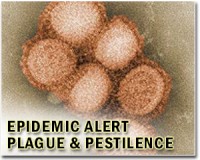| . |  |
. |
Washington DC (SPX) Nov 08, 2010 When a team of European researchers sought to discover how a class of antiviral drugs worked, they looked in an unlikely place: the sugar dish. A new research report appearing in the Journal of Leukocyte Biology suggests that a purified and modified form of a simple sugar chain may stop fast-acting and deadly viruses, such as Ebola, Lassa, or Marburg viruses, in their tracks. This compound, called chlorite-oxidized oxyamylose or COAM, could be a very attractive therapeutic option because not only did this compound enhance the early-stage immune defenses in mice, but because of sugar's abundance, it is derived from easily obtainable sources. "We modified and purified a safe drug from natural sources and discovered how it can protect against deadly virus infections," said Ghislain Opdenakker, M.D., a researcher involved in the study from the Laboratory of Immunobiology at the Rega Institute for Medical Research and the University of Leuven in Belgium. To make this discovery, researchers infected mice with a virus that kills in less than a week. When one group of these infected mice was treated with an unpurified version of the compound, about half of the infected mice were protected from the effects of the virus. Researchers then purified the compound and treated another group of infected mice. In that group, more than 90 percent survived the deadly infection. These results suggest that the purified compound almost completely blocked the killer virus by speeding the response of the body's fast-acting immune cells, called white blood cells or leukocytes, at the early stage of infection. "This is an exciting discovery because it offers hope that we will finally be able to really do something about some of the world's deadliest viruses - rapidly mobilizing antiviral immune cells is critical in the race between these killer viruses and the host," said John Wherry, Ph.D., Deputy Editor of the Journal of Leukocyte Biology. "The fact that this compound comes from something as abundant as sugar just sweetens the findings." Sandra Li, Sofie Starckx, Erik Martens, Chris Dillen, Nathalie Lamerant-Fayel, Nele Berghmans, Mieke Gouwy, Melissa van Pel, Hubertine Heremans, Claudine Kieda, Willem E. Fibbe, Alfons Billiau, Jo Van Damme, and Ghislain Opdenakker. Myeloid cells are tunable by a polyanionic polysaccharide derivative and co-determine host rescue from lethal virus infection. J Leukoc Biol November 2010 88:1017-1029; doi:10.1189/jlb.1109724. Reference.
Share This Article With Planet Earth
Related Links Federation of American Societies for Experimental Biology Journal of Leukocyte Biology Epidemics on Earth - Bird Flu, HIV/AIDS, Ebola
 Brazil's Lula to visit Mozambican anti-retroviral plant
Brazil's Lula to visit Mozambican anti-retroviral plantMaputo (AFP) Nov 7, 2010 Brazilian President Luiz Inacio Lula da Silva will visit what is set to become Africa's first public factory to produce anti-AIDS drugs, during a state visit to Mozambique that begins Tuesday. The two-day visit will bookend his presidency, underscoring his efforts to reach out to Africa by helping Mozambique, a fellow former Portuguese colony, follow in Brazil's footsteps in the fight agains ... read more |
|
| The content herein, unless otherwise known to be public domain, are Copyright 1995-2010 - SpaceDaily. AFP and UPI Wire Stories are copyright Agence France-Presse and United Press International. ESA Portal Reports are copyright European Space Agency. All NASA sourced material is public domain. Additional copyrights may apply in whole or part to other bona fide parties. Advertising does not imply endorsement,agreement or approval of any opinions, statements or information provided by SpaceDaily on any Web page published or hosted by SpaceDaily. Privacy Statement |